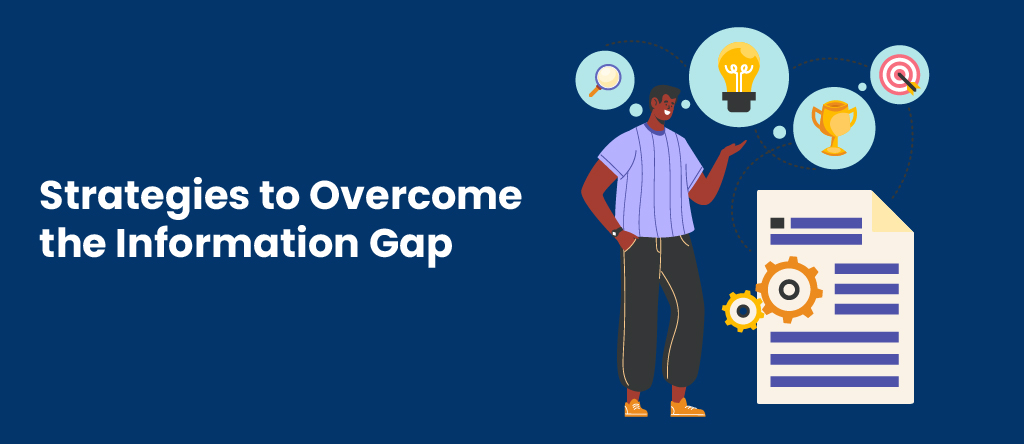Imagine, there is a modern company that consists of endless opportunities and the same amount of challenges. In the middle of this scenario, the business leaders are navigating their companies through unfamiliar circumstances. They are equipped with only one important tool – the power of INFORMATION.
However, despite all the technical advancements and data-driven decisions, there is a constant void called – ‘THE INFORMATION GAP’. this information gap can hinder a lot of companies and businesses from making data-driven and timely decisions.
In this article, we will dive into the world of the information gap, and explore its challenges along with discussing the strategies that will help overcome the information gap. Let’s begin with understanding the information gap!
What is the Information Gap?

Here, the information gap defines as the imbalance between the data/information that the decision-makers require to make informed decisions and the data/information that they actually have. Incomplete data, data walls within an organization, a lack of real-time information, and the enormous volume of data that makes it difficult to derive useful insights are just a few of the contributing factors that can lead to this gap.
Challenges That Cause the Information Gap

1. Incomplete Data
Sometimes the decision-makers do not have access to updated and detailed data/information. This leaves them with only one option, i.e. relying on predictions or some historical data that doesn’t always match the current scenario accurately. This can result in insignificant decisions and missed opportunities.
2. Delay in Responses
It is a fast-moving business environment and decision-makers should also be quick to make vital decisions. Decision-makers often miss the opportunity of transforming emerging trends or potential issues into capitalizing opportunities while waiting for the manually compiled data. This can lead to losses too!
3. Risk Management
When real-time data is not available, it becomes difficult to identify and navigate risks immediately. Companies could feel unprepared for unexpected market changes or disruptions in the industry.
4. Competitive Disadvantage
Companies that are unable to fill the information gap have a risk of lagging behind their competitors. The competitors here are the businesses that are experts in utilizing data-driven information to optimize processes, accelerate innovation, and stay at the top of market trends.
Strategies to Overcome the Information Gap

1. Implement Real-Time Data Analytics
Utilizing real-time data analytics solutions allows businesses to access up-to-date information enabling them to make informed decisions on the basis of the current market dynamics. Modern analytics platforms have the ability to process enormous amounts of data quickly, providing valuable insights that were previously inaccessible.
2. Break Down Data Barriers
Sometimes businesses struggle with challenges related to data compartmentalization, where data/information becomes isolated within specific systems or departments. For a more comprehensive understanding of the business, it is essential to break down these barriers and integrate the data from different sources. This will allow the decision-makers to make accurate and informed decisions.
3. Adopt Predictive Analytics
Predictive analytics leverage historical data and ML algorithms to forecast upcoming market trends and outcomes. With these predictive analytics, companies can look for any potential challenges as well as opportunities, enabling them to solve the issues immediately before they become too bad.
4. Invest in Data Visualization Tools
Perfect data interpretation is not just an option but a necessity. Sometimes, it can get challenging to interpret some complex data leaving you with confusion and misinterpretations. To avoid this, you need to invest in data visualization tools that will help you transform your raw data into the form of graphs, dashboards, and charts which are easy to understand. Such data visualization can make the data interpretation process effortless and quick.
5. Encourage Data Literacy
It is very important for employees at all levels to be aware and understand how data analytics and data interpretation work. To fill this gap between the data-related skills and the employees, training programs and workshops must be arranged that can encourage them to make more data-driven decisions.
6. Communication and Collaboration
Communication is a very powerful concept. Businesses must allow open communication among all departments. Cross-functional collaboration among the departments is also highly encouraged. With such powerful communication and collaboration among departments, the teams get a chance to exchange data and insights. Such discussions always benefit decision-makers as there is a lot of knowledge and perspective involved, ultimately resulting in flawless informed decisions.
To Wrap Things up
Business information is something that has become a necessity for many businesses as it enables them to make informed decisions. However, there is a lot of information gap in the market of all sizes leading to wrong decisions and failed strategies. Now that we know all about the causes that create the information gap, you can easily overcome them with the strategies to meet your organizational goals.

